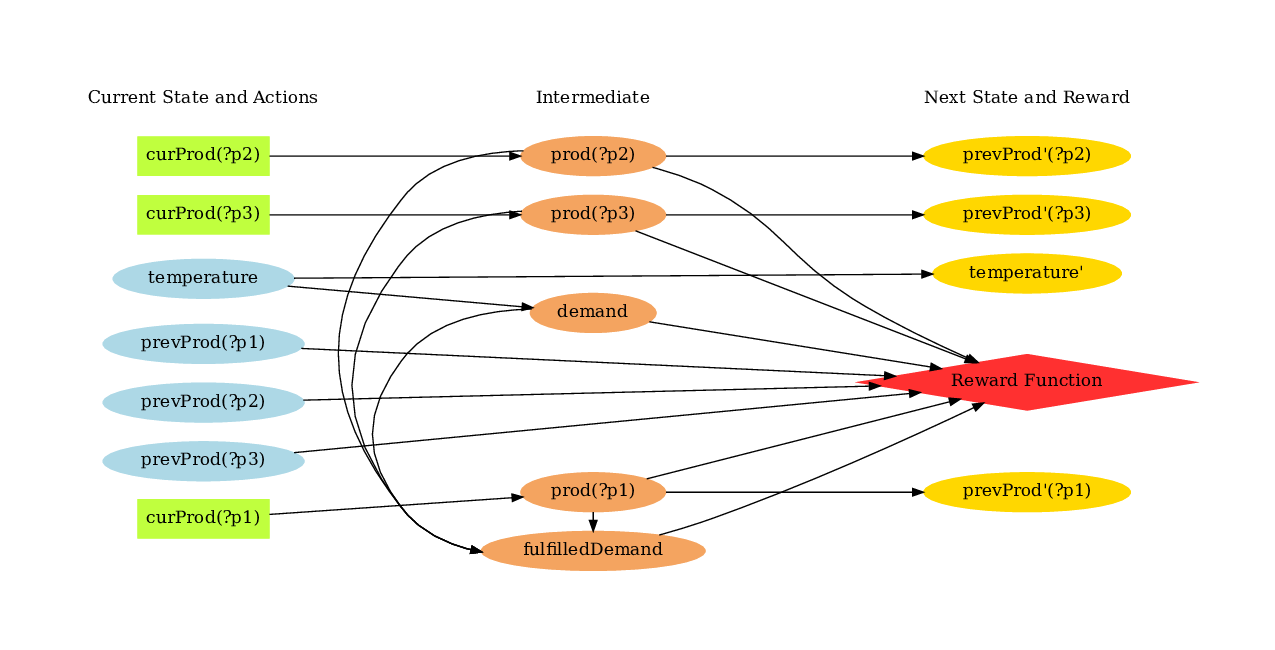Visualizing DBNs (Dynamic Bayes Nets) with XADD
With the XADD compilation of a given domain instance, you can easily visualize the dependencies between different fluents. For this purpose, you can use the provided visualization tool that gives you a way to produce diagrams similar to an influence diagram.
Specifically, you can use the pyRDDLGym/Visualizer/visualize_dbn.py file. In this page, we will take you through how to use this file for nicely visualizing a RDDL domain instance.
To begin with, you need to install the following:
Make sure you have activate the right conda environment with conda activate YOUR_CONDA_ENVIRONMENT. Now, we give a step-by-step guide to installing the necessary packages.
sudo apt-get install graphviz graphviz-dev
sudo dnf install graphviz graphviz-devel
brew to install graphviz.brew install graphviz
Unfortunately, we do not provide support for Windows systems, though you can refer to the pygraphviz documentation for information.
pip install pygraphviz
python -m pip install \
--global-option=build_ext \
--global-option="-I$(brew --prefix graphviz)/include/" \
--global-option="-L$(brew --prefix graphviz)/lib/" \
pygraphviz
Note that due to the default installation location by brew, you need to provide some additional options for pip installation.
XADD (eXtended Algebraic Decision Diagram) [Sanner at al., 2011] enables compact representation and operations with symbolic variables and functions. In fact, the data structure can be used to represent CPFs defined in a RDDL domain once it is grounded for a specific RDDL instance. You can find more detailed description of the XADD compilation step in this page.
We use the xaddpy package that provides a Pure Python implementation of XADD (originally implemented in Java). To install the package, simply run the following:
pip install xaddpy
With the necessary tools being installed, we can now go ahead and draw DBN diagrams of various RDDL domain/instances. As a running example, we show how you can visualize a Wildfire instance as defined in pyRDDLGym/Examples/Wildfire.
Firstly, you can instantiate a RDDL2Graph object by specifying the domain, instance, and some other parameters.
from pyRDDLGym.Visualizer.visualize_dbn import RDDL2Graph
r2g = RDDL2Graph(
domain='Wildfire',
instance=0,
directed=True,
strict_grouping=True,
)
Then, you can visualize the corresponding DBN by calling
r2g.save_dbn(file_name='Wildfire')
which will save a file named Wildfire_inst_0.pdf to ./tmp/Wildfire. Additionally, you can check the Wildfire_inst_0.txt file which records grounded fluent names and their parents in the DBN.
The output of the function call looks like this (opens a new tab showing the PDF file, which we omit to include here since it would take up quite some space).
You can also specify a single fluent and/or a ground fluent that you are interested in for visualization. For example,
r2g.save_dbn(file_name='Wildfire', fluent='burning', gfluent='x1_y1')
will output the following graph.

huh, Nice! You can see from this diagram that the next state transition of the burning state at (x1, y1) only depends on 6 grounded variables (i.e., whether neighboring cells are burning; whether this location is out of fuel; whether the put-out action has been taken).
To give you a taste of another example, here’s the DBN visualization of the Power Generation instance, in which intermediate variables are placed in the middle column:
